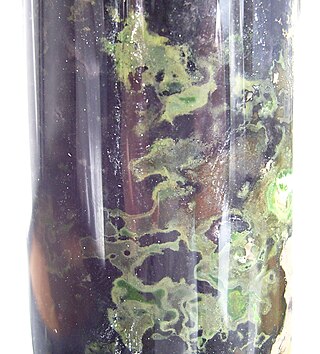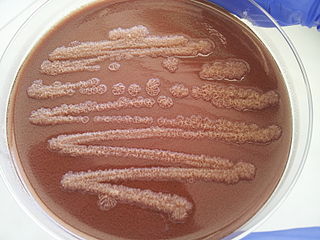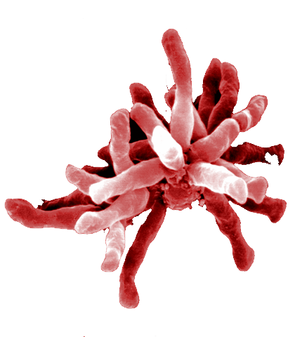
The green sulfur bacteria are a phylum, Chlorobiota, of obligately anaerobic photoautotrophic bacteria that metabolize sulfur.

Obligate anaerobes are microorganisms killed by normal atmospheric concentrations of oxygen (20.95% O2). Oxygen tolerance varies between species, with some species capable of surviving in up to 8% oxygen, while others lose viability in environments with an oxygen concentration greater than 0.5%.

Sulfur-reducing bacteria are microorganisms able to reduce elemental sulfur (S0) to hydrogen sulfide (H2S). These microbes use inorganic sulfur compounds as electron acceptors to sustain several activities such as respiration, conserving energy and growth, in absence of oxygen. The final product of these processes, sulfide, has a considerable influence on the chemistry of the environment and, in addition, is used as electron donor for a large variety of microbial metabolisms. Several types of bacteria and many non-methanogenic archaea can reduce sulfur. Microbial sulfur reduction was already shown in early studies, which highlighted the first proof of S0 reduction in a vibrioid bacterium from mud, with sulfur as electron acceptor and H
2 as electron donor. The first pure cultured species of sulfur-reducing bacteria, Desulfuromonas acetoxidans, was discovered in 1976 and described by Pfennig Norbert and Biebel Hanno as an anaerobic sulfur-reducing and acetate-oxidizing bacterium, not able to reduce sulfate. Only few taxa are true sulfur-reducing bacteria, using sulfur reduction as the only or main catabolic reaction. Normally, they couple this reaction with the oxidation of acetate, succinate or other organic compounds. In general, sulfate-reducing bacteria are able to use both sulfate and elemental sulfur as electron acceptors. Thanks to its abundancy and thermodynamic stability, sulfate is the most studied electron acceptor for anaerobic respiration that involves sulfur compounds. Elemental sulfur, however, is very abundant and important, especially in deep-sea hydrothermal vents, hot springs and other extreme environments, making its isolation more difficult. Some bacteria – such as Proteus, Campylobacter, Pseudomonas and Salmonella – have the ability to reduce sulfur, but can also use oxygen and other terminal electron acceptors.

Pseudomonas stutzeri is a Gram-negative soil bacterium that is motile, has a single polar flagellum, and is classified as bacillus, or rod-shaped. While this bacterium was first isolated from human spinal fluid, it has since been found in many different environments due to its various characteristics and metabolic capabilities. P. stutzeri is an opportunistic pathogen in clinical settings, although infections are rare. Based on 16S rRNA analysis, this bacterium has been placed in the P. stutzeri group, to which it lends its name.

Rhodopseudomonas palustris is a rod-shaped, Gram-negative purple nonsulfur bacterium, notable for its ability to switch between four different modes of metabolism.
Afifella is a genus in the phylum Pseudomonadota (Bacteria). Afifella are found in marine and estuarine settings, including microbial mats. They are anaerobes, with one cultured representative capable of photosynthesis.
CandidatusScalindua wagneri is a Gram-negative coccoid-shaped bacterium that was first isolated from a wastewater treatment plant. This bacterium is an obligate anaerobic chemolithotroph that undergoes anaerobic ammonium oxidation (anammox). It can be used in the wastewater treatment industry in nitrogen reactors to remove nitrogenous wastes from wastewater without contributing to fixed nitrogen loss and greenhouse gas emission.

Geothrix fermentans is a rod-shaped, anaerobic bacterium. It is about 0.1 µm in diameter and ranges from 2-3 µm in length. Cell arrangement occurs singly and in chains. Geothrix fermentans can normally be found in aquatic sediments such as in aquifers. As an anaerobic chemoorganotroph, this organism is best known for its ability to use electron acceptors Fe(III), as well as other high potential metals. It also uses a wide range of substrates as electron donors. Research on metal reduction by G. fermentans has contributed to understanding more about the geochemical cycling of metals in the environment.
Shewanella violacea DSS12 is a gram-negative bacterium located in marine sediment in the Ryukyu Trench at a depth of 5,110m. The first description of this organism was published in 1998 by Japanese microbiologists Yuichi Nogi, Chiaki Kato, and Koki Horikoshi, who named the species after its violet appearance when it is grown on Marine Agar 2216 Plates.
Rhodoferax fermentans is a psychrophilic, motile bacterium from the genus Rhodoferax. It is a photosynthetic bacteria.
Lautropia mirabilis is a Gram-negative, facultatively anaerobic, oxidase- and catalase-positive, motile bacterium of the genus Lautropia and family Burkholderiaceae, isolated from the mouth of children who were infected with human immunodeficiency virus.
Rhodovulum sulfidophilum is a gram-negative purple nonsulfur bacteria. The cells are rod-shaped, and range in size from 0.6 to 0.9 μm wide and 0.9 to 2.0 μm long, and have a polar flagella. These cells reproduce asexually by binary fission. This bacterium can grow anaerobically when light is present, or aerobically (chemoheterotrophic) under dark conditions. It contains the photosynthetic pigments bacteriochlorophyll a and of carotenoids.
Geobacter metallireducens is a gram-negative metal-reducing proteobacterium. It is a strict anaerobe that oxidizes several short-chain fatty acids, alcohols, and monoaromatic compounds with Fe(III) as the sole electron acceptor. It can also use uranium for its growth and convert U(VI) to U(IV).
Desulfitobacterium dehalogenans is a species of bacteria. They are facultative organohalide respiring bacteria capable of reductively dechlorinating chlorophenolic compounds and tetrachloroethene. They are anaerobic, motile, Gram-positive and rod-shaped bacteria capable of utilizing a wide range of electron donors and acceptors. The type strain JW/IU-DCT, DSM 9161, NCBi taxonomy ID 756499.
Anaeromyxobacter dehalogenans is a species of bacteria. It is an aryl-halorespiring facultative anaerobic myxobacterium. Its cells are slender, gram-negative rods with a bright red pigmentation that exhibit gliding motility and form spore-like structures. The type strain is 2CP-1. Anaeromyxobacter dehalogenans have been found to grow under a minimal amount of electrons acceptors.
Desulfitobacterium hafniense is a species of gram positive bacteria, its type strain is DCB-2T..
Rhodobacter capsulatus is a species of purple bacteria, a group of bacteria that can obtain energy through photosynthesis. Its name is derived from the Latin adjective "capsulatus", itself derived Latin noun "capsula", and the associated Latin suffix for masculine nouns, "-atus".
Dinoroseobacter shibae is a facultative anaerobic anoxygenic photoheterotroph belonging to the family, Rhodobacteraceae. First isolated from washed cultivated dinoflagellates, they have been reported to have mutualistic as well as pathogenic symbioses with dinoflagellates.
Rhodoferax saidenbachensis is a Gram-negative and rod-shaped bacterium from the genus Rhodoferax which has been isolated from fresh water of the Saidenbach reservoir in Germany.
Thiodictyon is a genus of gram-negative bacterium classified within purple sulfur bacteria (PSB).





